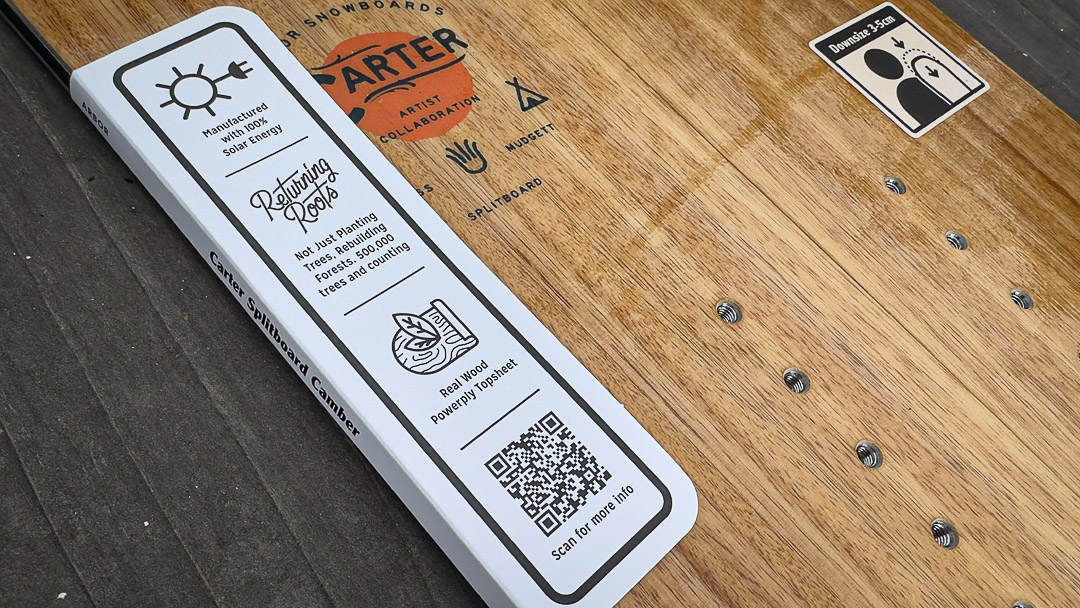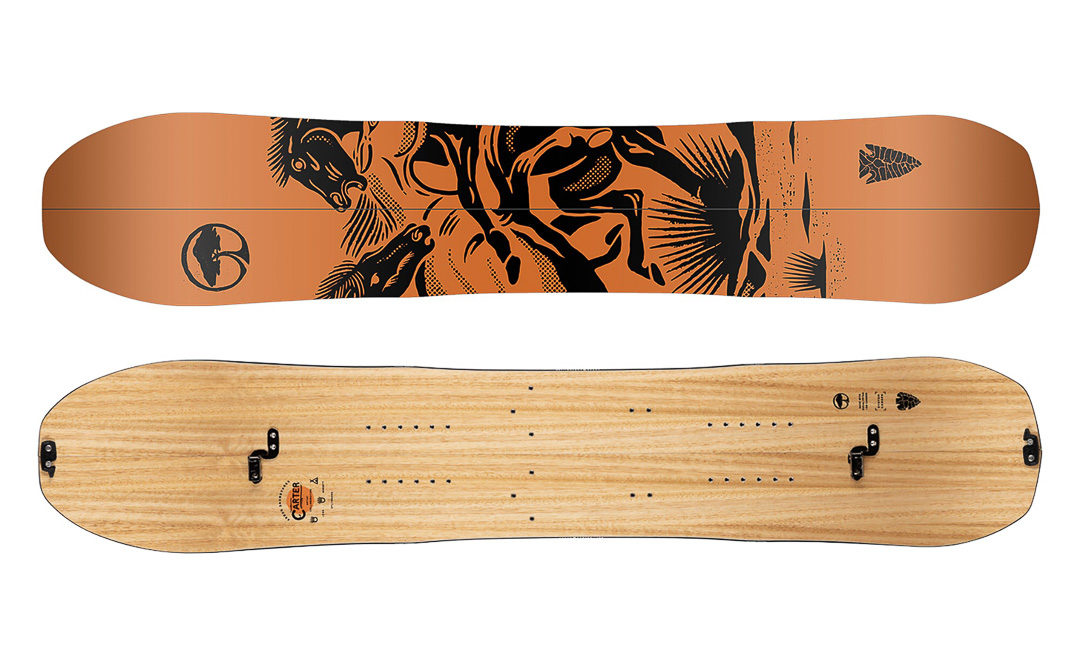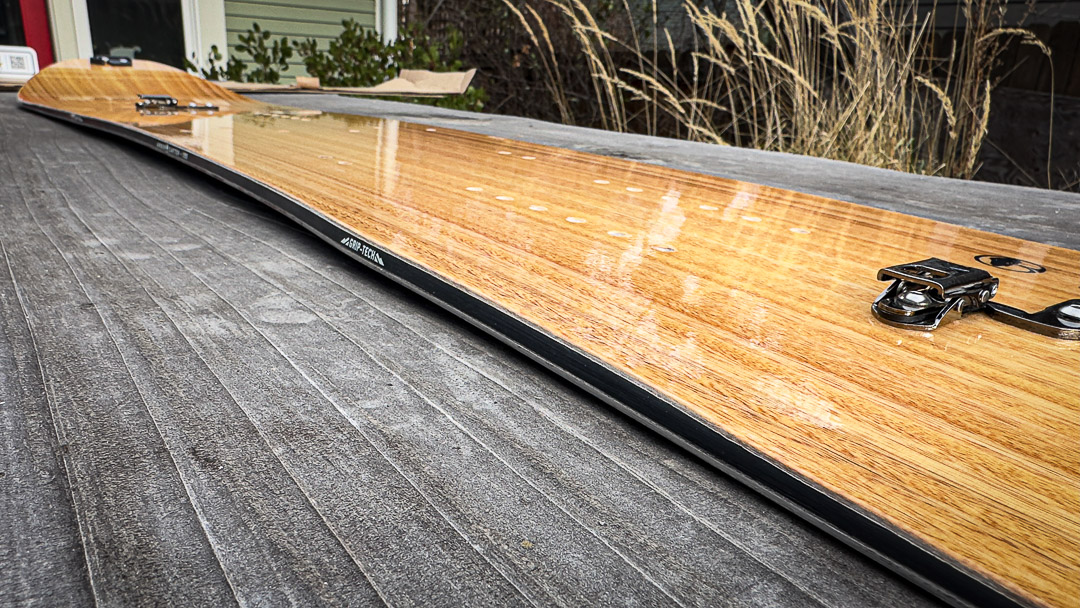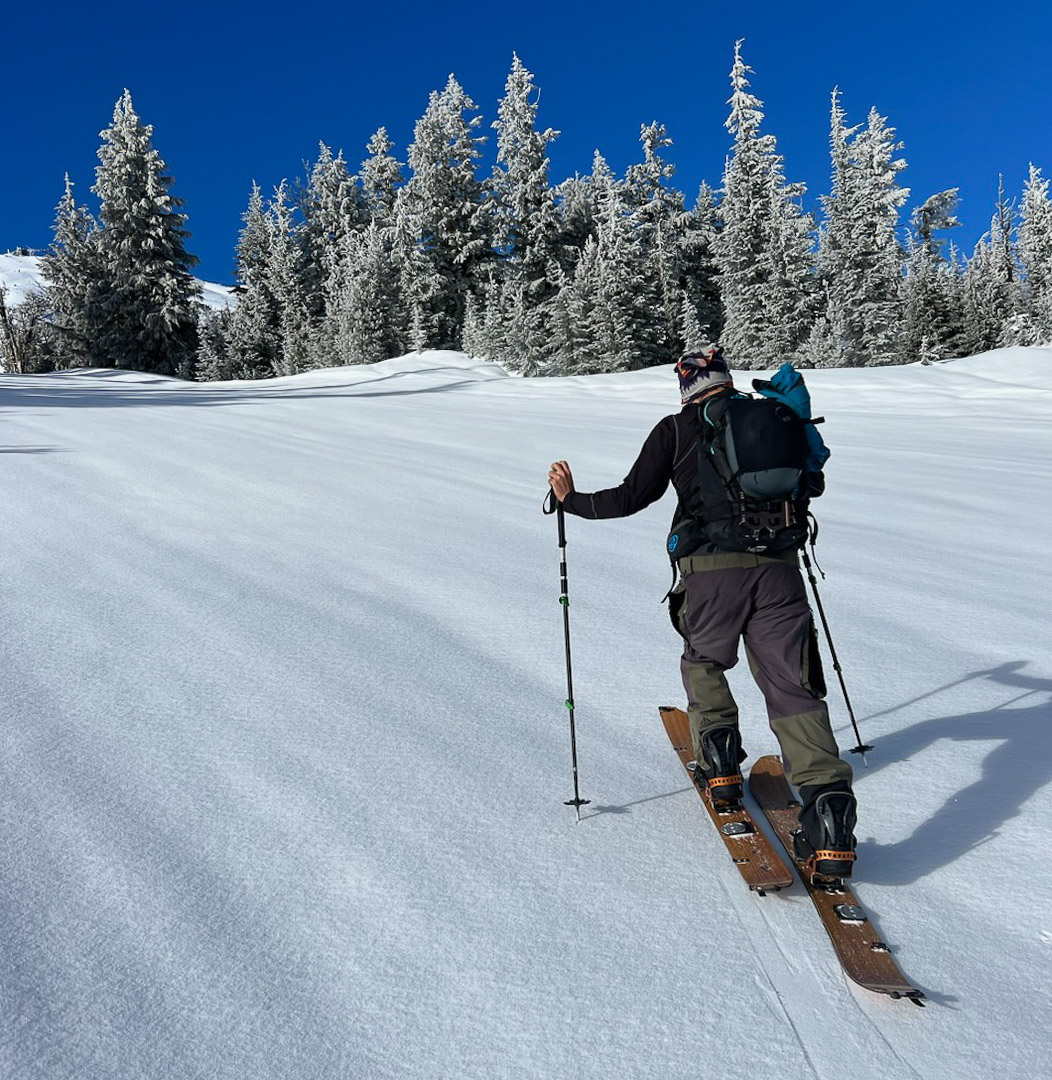A first look at the Carter Camber split—a board marketed to size down but not compromise in float and stability.
The Split
We had just come out of a nice early-season storm cycle: three days of cold snow, high winds, and good storm riding. Sadly, a high-elevation snow-then-rain event on day four ended that. We were left with an interesting batch of conditions. On the plus side, the sharks lurking in our early season base were now visible. Also, the snow in the alpine, although not powder or true corn snow, seemed smooth, and with sunny, warm temperatures arriving, I figured this was a great period to test some new equipment.
The Arbor Carter Camber Splitboard caught my eye while browsing the Arbor line of splits for 2024. A sleek and low-key skate-style wooden top sheet and artwork on the base by Jess Mudgett are the first to catch one’s eye. Upon further examination, some interesting technical aspects of the Carter stand out. Because of its wider waist and underfoot dimensions, the board is designed to be sized down in length 3 to 5 centimeters shorter than what folks usually ride. I usually ride a 158 (a Cardiff Bonzai 158 for example), and sized down to the 155 Carter Camber split.
Decently wide but not a boat, the Carter certainly has a unique and powerful-looking shape. In the long term, I’d like to find a nimble and stable enough board to handle hop-turning firm snow while fun and surfy enough to jump and fly through our local old growth. Another thing that stood out when I was checking out the board in person was the radical edge design. When looking down the board’s edge, Arbor’s edge technology, Grip Tech, becomes apparent: the edge/profile protrudes slightly (see photo). Grip Tech is designed to add heel and toe contact points in the places that matter. We’ll see how this works in the hills.



The Skins
Arbor also sells skins compatible with their boards. Kohla, a skin manufacturer based in the Tyrolean Alps, produces skins for Arbor. The skins are lightweight, compact, and made from a Mohair and nylon blend. Cutting the skins to the board’s dimensions was easy. Markings on the tail indicate where to trim according to the board size. The straight-edge razor blade Arbor provides makes it an easy and precise task.
The tail clips don’t come installed, but the pieces and clear directions are provided. A hammer, plyers, and a wooden board are needed for this job. I got the tail clips installed properly and was pleased with my DIY job, but there is a small gap where the tail clip leaves the carpet; this seems minor, but snow could creep in that gap. I’m curious how long the simple riveting system holding the tail clips in place holds up. (On a side note, I’ve always preferred when the tail clips are already assembled, as a factory machine nails the fit.
In contrast, the nose clips on the skins are factory-assembled, and the fit is flawless. The skin lays down perfectly flush, and there is no gap whatsoever around the nose of the board and the skin connection. Sometimes with splitboards, this isn’t the case, and a gap develops. Overall, the skins are lightweight and highly functional, but I am curious about long-term durability.
Back on Snow
As mentioned earlier, my first day with this board was a smorgasbord of conditions. I rode the Carter Camber on the chairs to get a feel for the downhill performance. I sometimes do this with splits to play around with my stance and get a lot of riding in on various surfaces. I sought out and rode tracked and wet snow off the groomers, smooth and slushy groomed trails, icy groomed trails, and even found some breakable crust. Once I dialed in my stance and trusted the smaller size, I started to enjoy the board. It made quick work of some challenging wet snow and flowed through it. The edges felt sharp and made great contact. The width of the board underfoot for my shoe size seemed great. I had no heel drag, and the turning radius was very responsive. I took the board fast on some groomers, and it felt solid without much chatter.
On my next day on the board, I wanted to test the skins and how the board climbs and rides in the backcountry. I took it into the alpine at a nearby local peak, hoping to find sun-softened snow in the upper elevations. Sadly, the rain reached the top of our peaks, characteristic of the start of this El Niño winter in Oregon, and froze hard overnight. It was warm out, but a stout rain crust dominated the mountain with only true south aspects softening slightly. The board handled well and felt solid on the firm snow. Despite some challenging conditions, I could trust my heel edge and was impressed with the board.
One downside I noticed was that the top nose clip didn’t seem to stay in place and moved around while skinning and skiing—this proved a bit problematic on the split ski exit, as the clip shifted quite a bit. I wouldn’t be surprised if the nose clip snapped or became damaged over time. This is a fixable problem but is annoying and can leave you not riding for a week or two while the board is in the shop.
For my initial glance and first few days out on this board, I’m pleased with the overall shape and ride of the Carter. The board rides a bit bigger than its listed size while feeling sturdy on firm snow. Paired with the skins, this is a lighter and performance-orientated setup, but I am concerned with a few durability issues. Hopefully, things will start turning on more here, and I can test this in some powder and a variety of conditions reminiscent of winter rather than spring.
The Carter Camber Stats
Sizes (cm): 155 (tested), 158, 161
Effective Edge (mm): 1162
Tip Width (mm): 209
Waist Width (mm): 266
Tail Width (mm): 301
Sidecut Radius (m): 8.95/ 8.05/ 8.95
Stance Setback (mm): 20
Stance Range (mm): 540
Suggested Rider Weight (lbs): 128-208
Price: $824.95
Kohla SplitGrip Skins: $230 — Kohla 65/35 Mohair/Nylon blend






Leave a Reply
You must be logged in to post a comment.